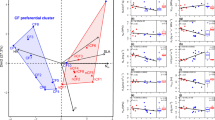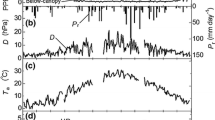Abstract
Climate warming predicts changes to the frequency and height of cloud-immersion events in mountain communities. Threatened southern Appalachian spruce–fir forests have been suggested to persist because of frequent periods of cloud immersion. These relic forests exist on only seven mountaintop areas, grow only above ca. 1,500 m elevation (maximum 2,037 m), and harbor the endemic Abies fraseri. To predict future distribution, we examined the ecophysiological effects of cloud immersion on saplings of A. fraseri and Picea rubens at their upper and lower elevational limits. Leaf photosynthesis, conductance, transpiration, xylem water potentials, and general abiotic variables were measured simultaneously on individuals at the top (1,960 m) and bottom (1,510 m) of their elevation limits on numerous clear and cloud-immersed days throughout the growing season. The high elevation sites had 1.5 as many cloud-immersed days (75 % of days) as the low elevation sites (56 % of days). Cloud immersion resulted in higher photosynthesis, leaf conductance, and xylem water potentials, particularly during afternoon measurements. Leaf conductance remained higher throughout the day with corresponding increases in photosynthesis and transpiration, despite low photon flux density levels, leading to an increase in water potentials from morning to afternoon. The endemic A. fraseri had a greater response in carbon gain and water balance in response to cloud immersion. Climate models predict warmer temperatures with a decrease in the frequency of cloud immersion for this region, leading to an environment on these peaks similar to elevations where spruce–fir communities currently do not exist. Because spruce–fir communities may rely on cloud immersion for improved carbon gain and water conservation, an upslope shift is likely if cloud ceilings rise. Their ultimate survival will likely depend on the magnitude of changes in cloud regimes.




Similar content being viewed by others
References
Arthur FH, Hain FP (1986) Water potential of Fraser fir infested with balsam wooly adelgid (Homoptera, Adelgidae). Environ Entolmol 15:911–913
Bader M, Geloof I, Rietkerk M (2007) High solar radiation hinders tree regeneration above alpine treeline in northern Ecuador. Plant Ecol 191:33–45
Berry ZC, Smith WK (2012) Cloud pattern and water relations in Picea rubens and Abies fraseri, southern Appalachian Mountains, USA. Agric For Meteorol 162:27–34
Braun EL (1964) Deciduous forests of eastern North America. Hafner, New York
Brewer CA, Smith WK (1997) Patterns of leaf surface wetness for montane and subalpine plants. Plant Cell Environ 20:1–11
Brient F, Bony S (2012) Interpretation of the positive low-cloud feedback predicted by a climate model under global warming. Clim Dynam 29:501–520. doi:10.1007/s00382-011-1279-7
Brodribb TJ, Holbrook NM (2004) Diurnal depression of leaf hydraulic conductance in a tropical tree species. Plant Cell Environ 27:820–827
Bruck RI, Robarge WP (1988) Change in forest structure in the boreal montane ecosystem of Mount Mitchell, North Carolina. Eur J For Pathol 18:357–366
Bruijnzeel LA, Veneklaas EJ (1998) Climatic conditions and tropical montane forest productivity: the fog has not lifted yet. Ecology 79:3–9
Bruijnzeel LA, Scatena FN, Hamilton LS (2010) Tropical montane cloud forests: science for conservation and management. Cambridge University Press, New York
Burgess SSO, Dawson TE (2004) The contribution of fog to the water relations of Sequoia sempervirens (D. Don): foliar uptake and prevention of dehydration. Plant Cell Environ 27:1023–1034
Busing RT, Clebsch EEC, Eagar CC, Pauley EF (1988) Two decades of change in a Great Smoky Mountains spruce–fir forest. B Torrey Bot Club 115:25–31
Campbell GS, Norman JM (1998) An Introduction to environmental biophysics. Springer, New York
Clark JS, Beckage B, Camill P, Cleveland B, HilleRisLambers J, Lichter J, McLachlan J, Mohan J, Wyckoff P (1999) Interpreting recruitment limitation in forests. Am J Bot 86:1–16
Cogbill CV, White PS (1991) The latitude–elevation relationship for spruce–fir and treeline along the Appalachian mountain chain. Vegetation 94:153–175
Croke MS, Cess RD, Hameed S (1999) Regional cloud cover change associated with global climate change: case studies for three regions of the United States. J Climate 12:2128–2134
Day ME, Greenwood MS, White AS (2001) Age-related changes in foliar morphology and physiology in red spruce and their influence on declining photosynthetic rates and productivity with tree age. Tree Physiol 16:1195–1204
Delcourt HR, Delcourt PA (1984) Late-Quaternary history of the spruce–fir ecosystem in the southern Appalachian Mountain region. In: White PS (ed) The southern Appalachian spruce–fir ecosystem: its biology and threats. Research/resource management report SER-71. USDI, National Park Service, Southeast Regional Office, Atlanta, pp 22–35
Dengel S, Grace J (2010) Carbon dioxide exchange and canopy conductance of two coniferous forests under various sky conditions. Oecologia 164:797–808
Foster P (2001) The potential negative impacts of global change on tropical montane cloud forests. Earth-Sci Rev 55:73–106
Germino MJ, Smith WK, Resor AC (2002) Conifer seedling distribution and survival in an alpine-treeline ecotone. Plant Ecol 162:157–168
Goelz JCG, Burk TE, Zedaker SM (1999) Long-term growth trends of red spruce and Fraser fir at Mt. Rogers, Virginia, and Mt. Mitchell, North Carolina. For Ecol Manage 115:49–59
Graham EA, Mulkey SS, Kitajima K, Phillips NG, Wright SJ (2003) Cloud cover limits net CO2 uptake and growth of a rainforest tree during tropical rainy seasons. Proc Natl Acad Sci USA 100:572–576
Greenwood MS, O’Brien CL, Schatz JD, Diggins CA, Day ME, Jacobson GL, White AS, Wagner RG (2008) Is early life cycle success a determinant of the abundance of red spruce and balsam fir? Can J For Res 38:2295–2305
Gregory J, Webb M (2008) Tropospheric adjustment induces a cloud component in CO2 forcing. J Climate 21:58–71
Gu L, Baldocchi D, Verma SB, Black TA, Vesala T, Falge EM, Dowty PR (2002) Advantages of diffuse radiation for terrestrial ecosystem productivity. J Geophys Res 107. doi:10.1029/2001JD001242
IPCC (2007) In: Solomon S, Qin D, Manning M, Chen Z, Marquis M, Avery KB, Tignor M, Miller HL (eds) Climate change 2007: The physical science basis contribution of working group I to the fourth assessment report of the intergovernmental panel on climate change, Cambridge University Press, Cambridge
Ishibashi M, Terashima I (1995) Effects of continuous leaf wetness on photosynthesis: adverse aspects of rainfall. Plant Cell Environ 18:431–438
Ishii H, Hamada Y, Utsugi H (2012) Variation in light-intercepting area and photosynthetic rate of sun and shade shoots of two Picea species in relation to the angle of incoming light. Tree Physiol 32:1227–1236
Johnson DM, Smith WK (2006) Low clouds and cloud immersion enhance photosynthesis in understory species of a southern Appalachian spruce–fir forest (USA). Am J Bot 93:1625–1632
Johnson DM, Smith WK (2008) Cloud immersion alters microclimate, photosynthesis and water relations in Rhododendron catawbiense and Abies fraseri seedlings in the southern Appalachian Mountains, USA. Tree Physiol 28:385–392
Johnson DM, Woodruff DR, McCulloh KA, Meinzer FC (2009) Leaf hydraulic conductance, measured in situ, declines and recovers daily: leaf hydraulics, water potential and stomatal conductance in four temperate and three tropical tree species. Tree Physiol 29:879–887
Knapp AK, Smith WK (1990) Stomatal and photosynthetic responses to variable sunlight. What’s new in plant physiology. Physiol Plant 78:160–165
Letts MG, Mulligan M (2005) The impact of light quality and leaf wetness on photosynthesis in north-west Andean tropical montane cloud forest. J Trop Ecol 21:549–557
Mark AF (1958) The ecology of the southern Appalachian grass balds. Ecol Monogr 28:293–336
McLaughlin SB, Anderson CP, Edwards NT, Roy WK, Layton PA (1990) Seasonal patterns of photosynthesis and respiration of red spruce saplings from two elevations in declining southern Appalachian stands. Can J For Res 20:485–495
Min Q (2005) Impacts of aerosols and clouds on forest–atmosphere carbon exchange. J Geophys Res 110:D06203
Mohnen VA (1992) Atmospheric deposition and pollutant exposure of eastern US forests. Ecol Stud An 96:64–124
Morison JIL, Jarvis PG (1983) Direct and indirect effects of light on stomata. II. In Commelina communis L. Plant Cell Environ 6:103–109
Niinemets U (2002) Stomatal conductance alone does not explain the decline of foliar photosynthetic rates with increasing tree age and size in Picea abies and Pinus sylvestris. Tree Physiol 22:515–535
Oosting HJ, Billings WD (1951) A comparison of virgin spruce–fir forest in the northern and southern Appalachian system. Ecology 32:84–103
Pittillo JD, Smathers GA (1979) Phytogeography of the Balsam Mountains and Pisgah Ridge, southern Appalachian Mountains. Ver Geobot 68:206–245
Pounds JA, Fogden MPL, Campbell JH (1999) Biological response to climate change on a tropical mountain. Nature 398:611–615
Ramseur GS (1960) The vascular flora of high mountain communities of the southern Appalachians. J Elisha Mitch Sci S 76:81–112
Reed JE, Smith WK (2012) Stomatal frequency, distribution, and needle hydrophobicity in cloud forest spruce and fir, southern Appalachian mountains. Rurals Rev Undergrad Res Agric Life Sci 7:Article3
Reinhardt K, Smith WK (2008a) Impacts of cloud immersion on microclimate, photosynthesis, and water relations of Abies fraseri (Pursh.) Poiret in a temperate mountain cloud forest. Oecologia 158:229–238
Reinhardt K, Smith WK (2008b) Leaf gas exchange of understory spruce–fir saplings in relict cloud forests, southern Appalachian Mountains, USA. Tree Physiol 28:113–122
Richardson AD, Denny EG, Siccama TG, Lee X (2003) Evidence for a rising cloud ceiling in eastern North America. J Climate 16:2093–2098
Ruddiman WF (2008) Causes of warming over the last 125 years. In: Earth’s climate past and future. Freeman, New York, pp 325–342
Simonin KA, Santiago LS, Dawson TE (2009) Fog interception by Sequoia sempervirens (D. Don) crowns decouples physiology from soil water deficit. Plant Cell Environ 32:882–892
Smith WK, McClean TM (1989) Adaptive relationship between leaf water repellency, stomatal distribution and gas exchange. Am J Bot 76:465–469
Smith WK, Schoettle AW, Cui M (1991) Importance of leaf area measurement to the interpretation of gas exchange parameters of complex shoots. Tree Physiol 8:121–127
Smith WK, Germino MJ, Hancock TE, Johnson DM (2003) Another perspective on the altitudinal limits of alpine timberline. Tree Physiol 23:1101–1112
Still CJ, Foster PN, Schneider SH (1999) Simulating the effects of climate change on tropical montane cloud forests. Nature 398:608–610
Urban O, Janouš D, Acosta M, Czerný R, Marková I, Navrátil M, Pavelka M, Pokorný R, Šprtová M, Zhang R, Špunda V, Grace J, Marek ML (2007) Ecophysiological controls over net ecosystem exchange of mountain spruce stand. Comparison of the response in direct vs. indirect diffuse solar radiation. Glob Change Biol 13:157–168
Urban O, Klem K, Ač A, Havránková K, Holišová P, Navrátil M, Zitová M, Kozlová K, Pokorný R, Šprtová M, Tomášková I, Špunda V, Grace J (2012) Impact of clear and cloudy sky conditions on the vertical distribution of photosynthetic CO2 uptake within a spruce canopy. Func Ecol 26:46–55
White PS (1984) The southern Appalachian spruce–fir ecosystem, an introduction. In: White PS (ed) The southern Appalachian spruce–fir ecosystem: its biology and threats. USDI, National Park Service, Southeast Regional Office, Research/Resource Management Report SER-71, Atlanta, pp 1–21
White PS, Cogbill CV (1992) Spruce–fir forests of eastern North America. In: Eager C, Adams MB (eds) Ecology and decline of red spruce in the Eastern United States. Springer-Verlag, New York, pp 3–39
Whittaker RH (1956) Vegetation of the Great Smoky Mountains. Ecol Monogr 26:1–80
Young DR, Smith WK (1983) Effect of cloudcover on photosynthesis and transpiration in the subalpine understory species Arnica latifolia. Ecology 64:681–687
Zar JH (1999) Biostatistical analysis. Prentice-Hall, Upper Saddle River
Acknowledgments
Support was provided through a grant from the National Science Foundation (IOS 1122092), plus a Vecellio grant to Z. C. Berry through the Biology Department, Wake Forest University. Research was conducted under special activity permit no. R11-22 from the North Carolina Department of Environment and Natural Resources. Thanks to Lisa Crane and Brian Wilder of Mount Mitchell State Park for project insight and cooperation, to Jenny Reed for field assistance, and to Katherine D. Hitzhusen for manuscript advice.
Author information
Authors and Affiliations
Corresponding author
Additional information
Communicated by Ram Oren.
Rights and permissions
About this article
Cite this article
Berry, Z.C., Smith, W.K. Ecophysiological importance of cloud immersion in a relic spruce–fir forest at elevational limits, southern Appalachian Mountains, USA. Oecologia 173, 637–648 (2013). https://doi.org/10.1007/s00442-013-2653-4
Received:
Accepted:
Published:
Issue Date:
DOI: https://doi.org/10.1007/s00442-013-2653-4




